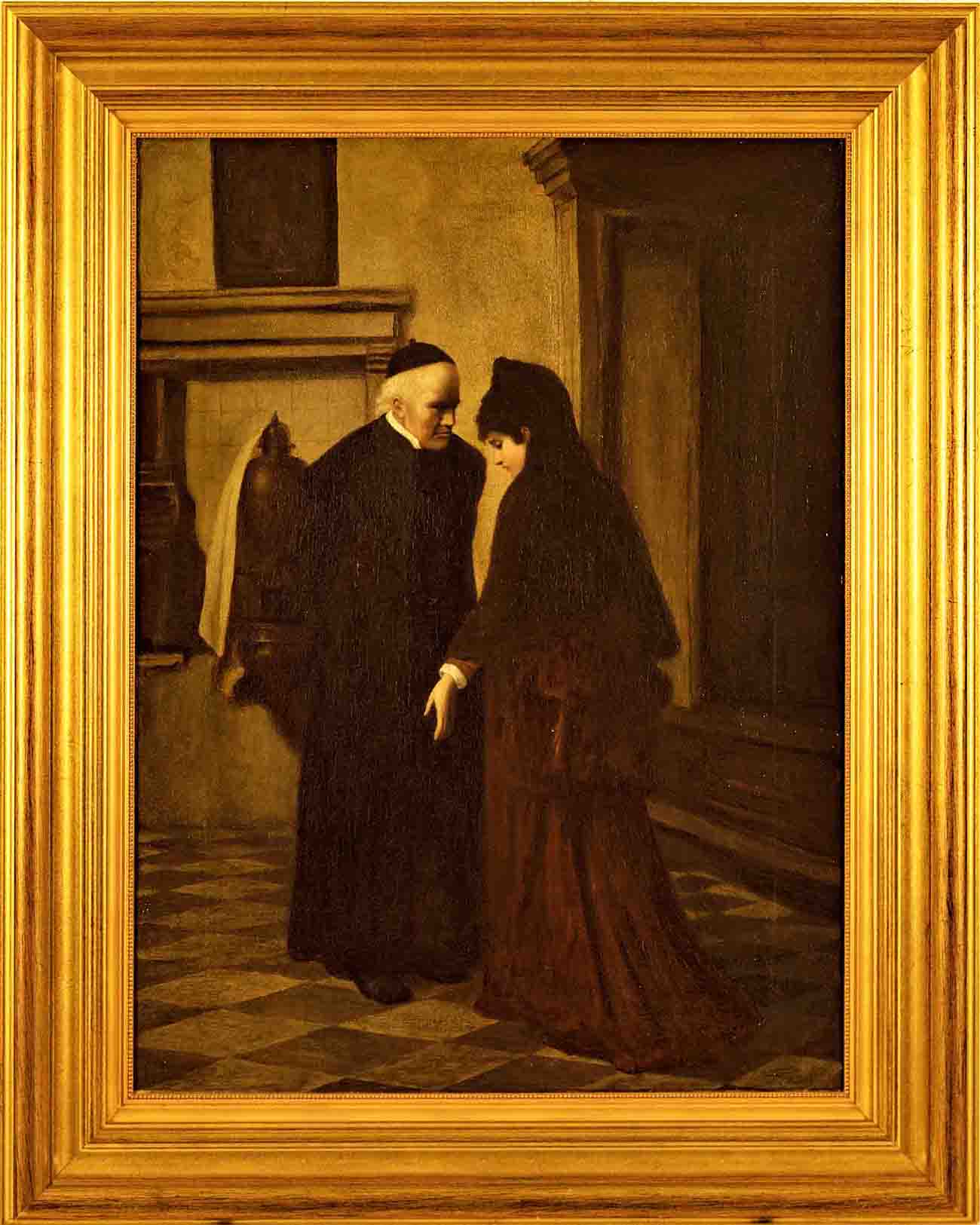画家:亨利.斯泰西.马克斯 Henry Stacy Marks(1829-1898)
作品:忏悔
种类:油画
尺寸:79cm×59cm 无签名
编号:OP150616ACJN12
亨利.斯泰西.马克斯于1829年出生在英国伦敦,是一位活跃于维多利亚时期的画家。亨利曾在摄政公园附近和艾索恩地区的小学校学习,在那里他学会画纹章符号。1846年左右,他参加了詹姆斯.马修斯.李艺术学校的夜校课程,在那里他和英国著名的社会现实主义画家弗雷德里克.沃克 (1840-1875)成为了朋友(亨利的弟弟后来娶了沃克的孪生妹妹)。在这期间,他曾为《家园圈》等杂志工作,制作剪纸插图。1851年12月,亨利进入英国皇家艺术学院学习。1952年,他决定和画家菲利普.赫莫杰尼斯.考尔德伦(1833-1898)一起前往巴黎,在法国新古典主义绘画大师弗朗索瓦.爱德华.皮科特(1786-1868)的工作室和巴黎美术学院学习。同年6月,他告别了考尔德伦,返回英国。 1853年首次在皇家艺术学院展出作品 ,该作品描绘了莎士比亚剧作《无事生非》中的一个场景。在19世纪50年代至60年代期间,亨利的创作灵感主要来源自莎士比亚的戏剧,因而描绘了大量中世纪场景。
从1856年10月起,因其父亲移居澳大利亚,亨利肩负起了赡养母亲、抚养三个弟弟的重任。他通过为各种顾客进行装饰工作来增补绘画的收入。他曾为彩色玻璃制造商克莱顿和贝尔工作,设计了皇家艾伯特厅的装饰墙,也曾为画家劳伦斯.阿尔玛-塔德玛(1836-1912)的房子进行装饰。1874至1880年期间,为威斯敏斯特公爵位于柴郡伊顿厅的房子做室内装饰。为此,他创作了两幅长达11米、取自《坎特伯雷故事集》的画作放置在沙龙里,并为客厅描绘了12幅以鸟类为主题的装饰画。
亨利和考尔德伦于1862年成立了圣约翰森林画派(the St. John's Wood Clique)。这个团体的目的是通过批判改进彼此,考尔德伦的座右铭是“每个人画得越好,对所有人都越有利”。亨利曾被弗雷德里克.沃克画进漫画《画派一景》中。前者是约翰.坦尼尔(1820-1914)和查尔斯.基恩(1823-1891)等几位漫画家的好友。
1888年,英国美术协会策划了一场关于鸟类的展览,亨利决定利用这个机会对鸟类进行深入的研究,并成为了动物园的常客。1890年,他创作的鸟类作品进行了一次私人展览。随着其绘画事业的发展,亨利对画鸟越来越感兴趣。也许他最著名的鸟类作品是创作于1891年的《一个特选委员会》,现收藏于沃克美术馆。在1878年展出另一幅鸟类作品《同学会》不久后,亨利被选为英国皇家艺术学院的成员。这两幅作品都表现出了画家对鸟类的喜爱,尤其是鹦鹉和副官鹳。一般来说,他的鸟类作品皆描绘了大鸟和五颜六色的鹦鹉。他的早期作品以油画为主,但许多鸟类画作是使用水彩创作完成的,并在旧水彩画协会或美术协会展出。他的毕业作品《科学就是测量》被认为一幅经典画品,描绘了一位科学家在一幅副官鹳的骨骼前进行测绘。这是亨利在为其早期绘画作测量时得到的创作灵感:“在研究鸟类时,我曾去皇家外科学院博物馆,测量鸟类骨头的长度和比例。当我得到了我需要的信息,从博物馆走出来,穿过林肯酒店的时候,我突然想起了我所从事的职业。这个场景显然提供了一个很好的绘画题材”。为了画这幅画,他征求了威廉.弗拉沃爵士的建议,让他把副官鹳的骨架放在家里,以便在空闲的时候进行研究学习。亨利从一位动物标本制作师的手中获得了一幅合适的标本。作品的标题在经过艺术家们和科学家们大量的讨论后,确定下来。 亨利提交了这幅毕业作品,并获得了皇家艺术学院的毕业证。在后来的几年里,他创作了大量描绘绍斯沃尔德和沃尔伯斯威克地区的风景画和海景画。
油画《忏悔》显然是画家较为早期的作品,尽管这幅作品没有署名,但根据亨利另一幅有签名的小稿,可以确定这是画家在1877年前后创作的绘画。这幅作品以全景式构图描绘了神父与教徒,主要表现了教徒忏悔这一世俗情节。画家以暗金色为主色调,表现了教堂室内的环境色,使画面营造出一种较为稳重、神圣的氛围。画面中,人物身上大量黑红色和深红色的运用,不仅增加了画面的视觉张力,同时也奠定了画面的情感基调—沉重、肃穆。画家又在人物面部、头发、手、衣领与袖口处,使用了明亮且偏冷的白色、浅银色和淡紫色,加以平衡、丰富整体色调,同时也使得视觉中心聚焦于人物面部。画面中人物形神兼备,眼神、姿态、衣着、心理和情绪都进行了有力刻画,用笔细腻、柔和,光线与色彩运用巧妙、精致。画中神父,双手背在腰后,认真、严肃地聆听教徒的忏悔。女教徒双手自然伸展,头微微下低。她眉头紧皱,眼神哀伤,似乎正沉浸在几近忧伤的缄默中。这种瞬间的沉默和宁静,可以看出画家对人物心理的深刻理解,以及其高超的绘画技巧。这幅作品中的神父,很可能曾做过画家另一幅作品的模特。 《忏悔》这幅作品,从背景色调的处理到人物表情的刻画来看,具有法国学院派古典主义的绘画风格,展现了画家深厚的写实技巧和色彩表现力,人物形象的塑造饱满且生动。
现如今,其作品大部分收藏于英国的机构和博物馆,包括英国皇家艺术学院、英国国家海事博物馆、皇家艾伯特纪念馆、伍尔弗汉普顿艺术与遗产、温彻斯特市议会地形艺术收藏、伯明翰博物馆信托、布里斯托尔博物馆、画廊与档案馆、库珀与牛顿博物馆、谢菲尔德博物馆、阿伯丁郡美术馆与博物馆、罗素科特斯美术馆与博物馆、沃克美术馆、曼彻斯特美术馆、莱恩美术馆和苏德雷公所。
Henry Stacy Marks (13 September 1829 in London – 9 January 1898 in London) was an English artist. Henry studied in small schools near Regent's Park and at Eythorne, Kent where he learned to paint heraldry symbols. Around 1846 he attended evening classes at James Mathews Leigh's art school where he would become a friend of Frederick Walker (Marks' younger brother later married Walker's twin sister). For some time he worked for magazines like Home Circle producing wood-cut illustrations. Henry enrolled successfully at the Royal Academy Schools in December 1851. In 1852 he however decided to move to Paris with his friend Philip Hermogenes Calderon to study at the atelier of François Edouard Picot and the École des Beaux-Arts. He returned in June 1852, leaving Calderon in Paris and first exhibited at the Royal Academy in 1853, painting a scene from Shakespeare's Much Ado about Nothing. His works during the 1850s and 1860s were predominantly based on Shakespeare's plays and depicted medieval scenes.
Henry ' father emigrated to Australia leaving Henry to support his mother, three brothers and from October 1856. He supplemented his income from painting by carrying out decorative work for various patrons. These included the Minton works, for the stained-glass manufacturers Clayton and Bell, by designing a frieze for the outside wall of the Royal Albert Hall, and for the house of the artist Lawrence Alma-Tadema. Marks worked on decorations for the house of the Duke of Westminster at Eaton Hall, Cheshire, between 1874 and 1880. For this purpose he painted two canvasses 35 feet (11 m) long of Chaucer's pilgrims in the saloon, and twelve panels of birds in the drawing room.
Henry was a founding member of the St John's Wood Clique in 1862 along with Calderon. The aim of the clique was to improve each other by critique and the motto framed by Calderon was "the better each man's picture, the better for all." He is shown in a cartoon A vision of the clique by Frederick Walker. Henry was a good friend of several of the cartoonists of Punch including John Tenniel and Charles Keene.
In 1888 the Fine Art Society planned an exhibition on birds and Marks decided to use this opportunity to take up an intensive study of birds and he became a regular visitor at the zoo. In 1890 he had a private exhibition on his bird works. As his career progressed, he became increasingly interested in painting birds. Possibly his most famous painting is A Select Committee (1891) which is now in the Walker Art Gallery. He was elected as a member of the Royal Academy following his painting Convocation, which was exhibited in 1878. Both of these demonstrated his interest in birds, in the former parrots and in the latter adjutant storks and in general his paintings depicted large birds and the colourful parrots. His early works were in oil, but many of his paintings of birds were watercolours, which he exhibited at the Old Watercolour Society or at the Fine Art Society. His diploma work Science is measurement depicting a scientist with measuring instruments before the skeleton of an adjutant stork is considered a classic. He got the idea of painting this scene while taking measurements for his earlier paintings. "In making studies of the birds, I went to the Museum of the Royal College of Surgeons to take measurements of the bones, their proportionate length, &c. When I had obtained what information I needed, I came away, and crossing Lincoln's Inn Fields, it struck me that the occupation in which I had been engaged would furnish a good subject for the picture." To paint this picture he asked for advice on obtaining a skeleton of the adjutant stork from Sir William Flower that could be kept at home so that he could study it at leisure. He got a suitable specimen from a taxidermy artist. The title was decided after much discussion with artists and scientists and he submitted it as his diploma picture for the Royal Academy of Arts. In later years he painted landscapes and seascapes based on studies in Southwold and Walberswick.
作品带框图:


